Weedy Pond |
Efforts have been made to remove invasive weeds to allow a pocket of Towra rainforest and a freshwater wetland to regenerate. |
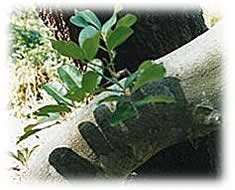 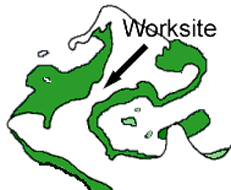 |
Background
In February 1998, the Sutherland Shire Environment Centre was successful in obtaining a grant from Coastcare to assist in weed eradication at Towra. The program, established via the Coastcare grant, is supplementing existing volunteer activities in the Reserve which are being conducted by NPWS. In its initial stages the aim of the project was to continue restoration of a pocket of littoral rainforest which is rare in the Sydney region.
In 1996, The Friends of Towra organised some initial removal of lantana in this area. The rainforest is a habitat for the tree species Syzygium paniculatum which is a threatened species in NSW. During the project period the rainforest was listed as an endangered ecological community under the NSW Threatened Species Conservation Act. The worksite also contains a small freshwater wetland (Weedy Pond).
The Problem |
 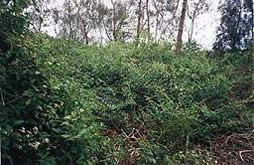 |
The photos give an indication of the density of the lantana and in some places, bitou bush understorey which exists in the rainforest near Weedy Pond, within the casuarina/banksia forest and along the shoreline. If the lantana is not removed then significant native species will not regenerate.
The Project
Stage 1, August 1998 - March 1999
During the first year of the project, extensive areas of weeds were removed from in and around the rainforest and wetland. In addition, an adjacent 60m stretch of the Reserve's western shoreline (to the immediate west of Weedy Pond) was also liberated from lantana understorey. |
  |
On-site work began in August 1998 with community volunteers, and members of the Como-Jannali Rotaract Club (above, left) who returned in September, October and December 1998. In March 1999 international backpackers (above, right) assisted with follow-up hand weeding as well as with removal of primary infestations of lantana.
As a result of extensive primary removal of lantana and subsequent follow-up handweeding (above), significant areas of bushland were rehabilitated during Stage 1 (below). You can see the contrast with the areas that were yet to be cleared seen here in the right background of the photo. |
 |
Stage 2, May 1999 - June 2000
Funding for the project was extended for 1999/2000 and attention was focussed on areas to the east of Weedy Pond. Work began in May 1999 with the assistance of a group of young unemployed people from the Green Corps 2000 program. |
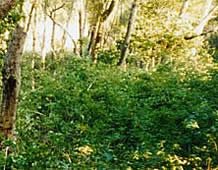 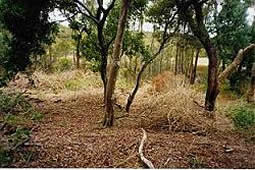 |
Progressive weed removal during late May/early June 1999 resulted in a breakthrough to the eastern shoreline. The photo left shows the density of the lantana on the eastern shore. The photo right shows the breakthrough on the eastern shore of the Reserve. The saltmarsh is visible towards the top right of the photo A continuous weed-free corridor had been created linking the two shorelines of the Nature Reserve. In September a group of Lend Lease personnel assisted with removing lantana who were followed by a group of TAFE students in October.
In May 2000, the Friends of Towra, who will take over management of the site in the second half of 2000, contributed their monthly work day to the project.
After extensive areas had been cleared of lantana and had undergone many stages of follow-up weeding, they were ready to be planted with native tubestock. This was done in May 2000 by Cub scouts and Venturers from Engadine, Gymea and Kirrawee as part of their conservation badge. |
 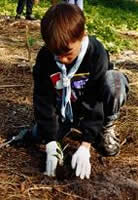 |
Mesurable Outcomes
Community Involvement The project provided an opportunity for the local and wider community to get involved in the preservation of the important ecosystems. All groups were also trained in bush regeneration techniques. Pictured below are some of the group of Lend Lease employees who contributed their Annual Community Day to the project in September 1999 |
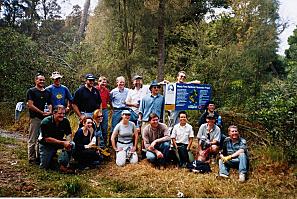 |
Public Awareness
Promotion of the project in the local community was achieved through a variety of avenues. The project was promoted through the local media via articles such as the one pictured. |
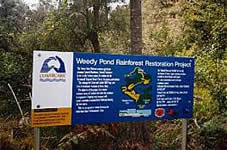 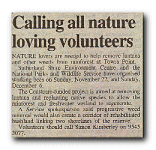 |
As part of the project a new sign was erected on the worksite. This sign, which is located adjacent to the track, contains information about the project, about Weedy Pond and the rainforest, and about ways people can get participate. A number of school groups and birdwatchers utilise the track and will have the chance to find out about the project.
Education
Not only did the project allow the community to get involved in preserving the area, it provided an opportunity to educate them about the significance of bush regeneration and about the importance of wetlands and littoral rainforest. TAFE students who assisted with removal of weeds on the site during October 1999 also took the opportunity to hone their plant identification skills using some of the rare and threatened species as examples. |
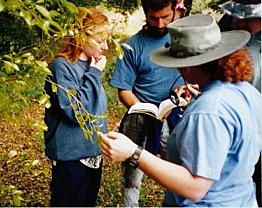 |
Significant on-ground outcomes
The photo below shows an area of the worksite cleared of lantana understorey during Stage 2. This forms part of the corridor of rehabilitated bushland linking the two shorelines. This area also contains a reasonably closed canopy of native rainforest species. This area was choked by weeds but by removing the lantana understorey a diverse range of native seedlings have now be given a second chance at survival |
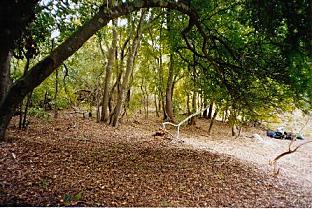 |
Acknowledgement
This project is funded by CoastCare - a co-operative Commonwealth/ State/ Local government program |
 |
|
| top of page |



